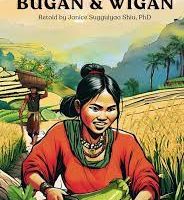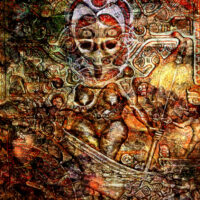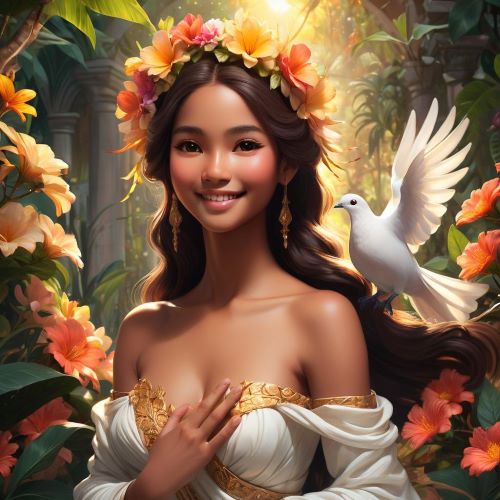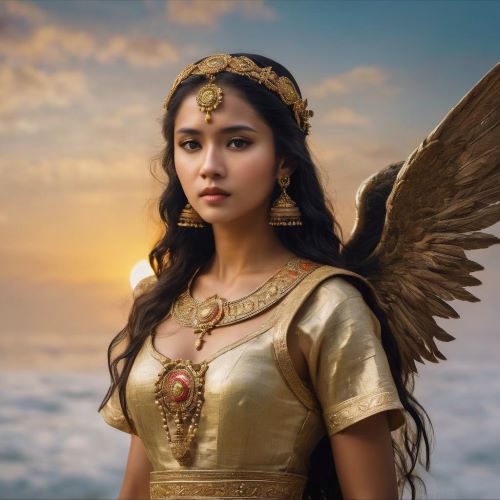Bugan : The Fertility Goddess
Listen
At a glance
| Description | |
|---|---|
| Origin | Philippine Mythology |
| Classification | Gods |
| Family Members | Hinumbian (Father), Dakaue (Mother), Wigan (Sibling) |
| Region | Philippines |
| Associated With | Fertility |
Bugan
Introduction
Bugan is a powerful figure in the mythology of the Ifugao people of Northern Luzon, Philippines. As a central goddess in many oral narratives, she represents themes of fertility, harmony, and the interconnection between divine forces and nature. Bugan’s influence extends beyond myth into the cultural fabric of the Ifugao, especially through their agricultural practices and sacred traditions. Often invoked in creation stories and rituals, Bugan serves as a symbol of life’s continuity, spiritual connection, and the nurturing presence that sustains both land and people.
Physical Traits
In the traditional epics and chants of the Ifugao, Bugan is rarely described in detail, yet her divine beauty and aura are universally acknowledged. Her presence is characterized by serenity, grace, and an ethereal charm that suggests her celestial origin. Her role as a goddess of fertility and life implies a nurturing essence, and she is often imagined with a radiance that reflects her spiritual importance. Some tales connect her with symbols of nature, like rainbows or owls, which are believed to have emerged from her divine form, adding a mystical layer to her identity as a being who transcends the ordinary.
Family
Bugan belongs to a significant lineage in Ifugao cosmology. She is often named as the daughter of the sky god Hinumbian and his consort Dakaue, placing her in the upper echelons of the divine world. Her familial relationships are foundational to the Ifugao understanding of ancestry and the divine origins of humankind. In one narrative, Bugan and her brother Wigan survive a catastrophic flood and become the progenitors of the Ifugao people, an act that binds her legacy to the very roots of human existence in the region. In alternate traditions, she marries the god Lumawig or the mortal hunter Kinggauan, with whom she bridges the realms of gods and men. These familial bonds not only explain human ancestry but also establish the divine right and sacred nature of agriculture and community in Ifugao life.
Other names
Throughout the diverse oral traditions of the Ifugao and surrounding ethnic groups, Bugan appears under various names and epithets. These variations are reflective of her complex nature and the fluid transmission of mythology across regions and generations. She is sometimes called “Bugan na Kan.talao” in chants to distinguish her from others with similar names. Her role as a fertility figure links her with Balitok, the deity of childbirth, while some Igorot narratives associate her with agricultural forces and even refer to her as a goddess of locusts, connecting her powers to both the blessings and challenges of farming life. These names and titles emphasize the wide scope of her influence and the reverence held for her among different communities.
Powers and Abilities
Bugan’s divine functions are rooted in her dominion over fertility, nature, and transformation. She ensures abundance in both crops and offspring, which are vital aspects of Ifugao livelihood. Her powers extend to healing, where she is known to alleviate ailments through ritualistic offerings such as eggs or chickens. In myth, Bugan’s body parts, after death or transformation, give rise to various elements of nature—rainbows, animals, and even illnesses—demonstrating her dual capacity to nurture and challenge. This aspect of her mythology reinforces her role as a goddess of balance, holding sway over both life’s blessings and its hardships. Bugan also serves as a mediator in sacred rites, connecting humans with the divine world and facilitating harmony between earthly and spiritual realms.
Modern Day Influence
Bugan’s legacy continues to resonate in contemporary culture, particularly within the Ifugao community and among scholars of indigenous Filipino heritage. The Hudhud chants, where Bugan is prominently featured, are recognized by UNESCO as vital components of humanity’s intangible cultural heritage. These narratives are now taught in schools, presented in festivals, and included in cultural preservation projects. Artists and writers frequently reinterpret Bugan’s stories, bringing her into visual arts, graphic novels, and modern literature, where she represents ancestral power and feminine strength. Moreover, her associations with nature and ecological balance are echoed in modern efforts to sustain the famed rice terraces, a living testament to the Ifugao’s environmental wisdom. As both a cultural icon and mythological figure, Bugan inspires a renewed appreciation for indigenous identity and the sacred traditions that continue to shape Filipino consciousness.
Related Images
Source
Barton, R. F. (1946). The Religion of the Ifugaos. Memoirs of the American Anthropological Association, No. 65.
Kroeber, A. L. (1918). History of Philippine Civilization as Reflected in Religious Nomenclature. American Museum of Natural History Anthropological Papers, Vol. 19, Part 2.
Almario, V. (Ed.). (2015). Sagisag Kultura Vol. 1. National Commission for Culture and the Arts. Retrieved from philippineculturaleducation.com.ph/bugan
Clark, J. (2017). Bugan and Kinggauan: Ifugao Marriage of a Goddess with a Man. The Aswang Project. Retrieved from aswangproject.com
Municipality of Asipulo. (n.d.). Mythological Background. Retrieved from asipuloifugao.gov.ph
Encyclopedia Mythica. (n.d.). Bugan inWigan. Retrieved from pantheon.org
Garcia, A. L., Ong, E., & Ong, W. (2019). Old Legends Never Die: Philippine Mythology in Modern Times. The LaSallian. Retrieved from thelasallian.com
Garcia, Z. (2023). Breathing Life into Philippine Folklore in the Modern World. Opinyon. Retrieved from opinyon.net
Frequently Asked Questions
What is lorem Ipsum?
I am text block. Click edit button to change this text. Lorem ipsum dolor sit amet, consectetur adipiscing elit. Ut elit tellus, luctus nec ullamcorper mattis, pulvinar dapibus leo.
What is lorem Ipsum?
I am text block. Click edit button to change this text. Lorem ipsum dolor sit amet, consectetur adipiscing elit. Ut elit tellus, luctus nec ullamcorper mattis, pulvinar dapibus leo.
What is lorem Ipsum?
I am text block. Click edit button to change this text. Lorem ipsum dolor sit amet, consectetur adipiscing elit. Ut elit tellus, luctus nec ullamcorper mattis, pulvinar dapibus leo.
What is lorem Ipsum?
I am text block. Click edit button to change this text. Lorem ipsum dolor sit amet, consectetur adipiscing elit. Ut elit tellus, luctus nec ullamcorper mattis, pulvinar dapibus leo.
What is lorem Ipsum?
I am text block. Click edit button to change this text. Lorem ipsum dolor sit amet, consectetur adipiscing elit. Ut elit tellus, luctus nec ullamcorper mattis, pulvinar dapibus leo.












